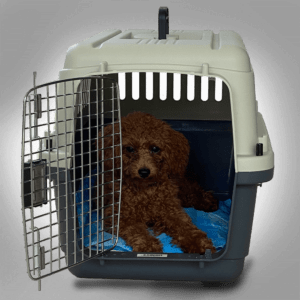A Guide To Getting It Right
Knowing how much to feed my puppy what to feed them and when is a big question for new puppy owners.
Puppies need the right nutrients and enough energy to grow into healthy adult dogs. For new puppy parents though, it can be hard to know what is “right” and “enough”.
Common questions are:
- What do 10-week old puppies eat?
- How often should I feed my puppy?
- How much to feed my puppy?
- What nutrients do puppies need?
- When should I start giving adult dog food to my puppy?
To help answers these questions, this guide will take you through the first year of a dog’s life so that you will know what to feed your puppy and when.
Which type of food is best for puppies?
Before we delve into the specifics of feeding a puppy, let’s take a quick look at the different types of puppy food on the market.
There are three types of dog food available: moist, semi-moist and dry kibble. For puppies, the best option is often dry kibble.
Why? Because kibble has more meat protein so it’s easy for puppies to digest and it’s good for their teeth. From a practical perspective, it’s easier to feed your puppy kibble, it’s more affordable and creates less mess.
Moist food is a good option and most puppies can digest this type of food. But it doesn’t have as many nutrients as dry kibble and it’s not as beneficial for their developing teeth. Plus, moist food can’t be stored for as long as kibble and it’s usually more expensive.
Semi-moist food in pre-packaged portions is a convenient alternative. However, it’s typically the most expensive option and has higher levels of salt, sugar and preservatives, which is not what a growing puppy needs.
A sensible compromise is to feed your puppy a mixture of dry kibble with moist food. This approach means your puppy gets the best of both worlds, while also enjoying some variety.
Now, let’s find out how much food your puppy needs at different ages.
Puppies at 6 to 12 weeks
Most people welcome a new puppy into their home when the pup is around 10-weeks-old. Until then, your puppy will have been nursed by its mother (up to six weeks) before being fed by the breeder.
This is why it’s important to feed the right food at the right time. Getting used to a new family and home can be a stressful time for a puppy. But food can be used to start bonding with your pup and make sure he or she stays healthy.
At this age, a puppy should only be fed puppy food. This means specially formulated food with the right ingredients.
Puppy food is rich in protein and DHA, an Omega fatty acid that is found in mother’s milk and is an essential nutrient. It also has higher levels of fat to maintain your pup’s energy levels while growing.
Think of feeding a puppy as like feeding a baby. Go for the highest quality and healthiest option so that your pup will grow up into a healthy dog.
Between the ages of six to 12 weeks, puppies need regular servings of small amounts of food. The recommended amount is four feedings a day.
Puppies at 3 to 6 months
Up to 12-weeks-old, puppies are usually quite chubby with a potbelly. But from around three months, your pup should start losing its fat as the body type grows and matures.
For some puppies though, this process takes a bit longer. If your puppy is still quite chubby with no signs of change at 12 weeks, then keep giving puppy size portions of food four times a day.
However, if your pup is developing well and losing its “puppy fat” then you can start to decrease feedings to three portions a day from this age. But stick with the nutrient-rich puppy food for now.
If you’re not sure whether to decrease the number of feedings per day then watch what happens when your puppy eats. If there is food left over in the dish or your pup refuses to eat, then it could be time to reduce the number of feedings. Or reduce the portion size.
Keep in mind that at around 16-weeks-old, adult teeth start to form and puppies will be happy to chew anything. It’s also around this time that you can start to introduce some meaty bones – as long as you pup doesn’t have a bad reaction to it.
Puppies at 6 to 12 months
Once your puppy reaches the half-year mark, you can start to reduce the feedings to twice a day. Depending on the breed and your puppy’s development.
For smaller breeds (up to 20 lbs), the ideal time for this is between seven and nine months. Bigger breeds usually need a bit longer because they have more growing to do, and might still need three meals a day up to 12-months-old.
Again, it’s best to monitor your dog’s feeding patterns to find out when is the best time to switch.
Smaller breed dogs also reach adulthood before medium (20 to 50 lbs) and larger breeds (over 50 lbs), so they might be ready for adult dog food from nine-months-old. Just remember, there is no harm in keeping your dog on puppy food for a bit longer if you’re not sure. But it could be harmful to start giving your puppy adult food too soon.
Another consideration around this time is spaying or neutering your puppy. If this is the route you choose to go down, then be aware that your pup’s energy levels could drop after the procedure. So keep an eye out for any changes in eating habits.
Puppies 12 months and older
It’s your puppy’s first birthday! Congratulations! The first year of having a puppy is always the hardest. And the most fun.
By the time your pup reaches one-year-old, he or she should be growing well. The general advice from dog experts is that when a puppy is one, owners should be feeding their dog twice a day. The recommended amount is two half portions – one in the morning and one early evening.
The reason for this is to stop your puppy from over eating and to establish a feeding routine. This is especially important as your pup becomes a full-grown adult dog.
If your puppy is not already on adult dog food by this age, be ready to make the switch in the coming months. Medium breed dogs tend to mature between 12 and 14 months. Larger dogs mature from between 12 and 24 months, but it will depend on the breed.
If in doubt, check with your vet or breeder.
How to switch from puppy food to adult dog food
The above timescales are a useful guide of what to feed your puppy during the first year. But when it comes to making the switch from puppy food to adult dog food, it will actually depend on your pup.
Puppy food is high in fat so if your pup starts skipping meals or leaving food unfinished, it could be a sign that the puppy food is becoming too hard to digest. If this happens, then consider moving to adult dog food.
The key to making the transition successful is to introduce gradual changes to the diet. Too much too soon and it could upset your pup’s stomach, as well as cause confusion.
Here’s how to do it:
- Start by adding a small amount of adult dog food to the puppy food
- Gradually increase this amount over seven days while decreasing the amount of puppy food
- By the end of the week you should only be feeding your dog adult food
It’s that simple. But do keep a close eye on your pup as you make the switch. If you notice any gastrointestinal issues then contact your vet for advice.
How to deal with a begging puppy
Any seasoned dog owners out there will be familiar with the begging puppy routine.
It usually happens when you sit down for dinner with the family. Puppies like to sit down next to someone’s chair and gaze up with big, pleading puppy eyes. Or even jump up and place paws on your lap while letting out a little cry.
If there’s no success with the first target, then your puppy will probably move onto the next person. And the next. It’s heart breaking to watch and ultimately someone will cave and slip a piece of meat under the table.
This is the exact moment your puppy learns that begging gets results.
Unfortunately, this happens on a daily basis in households around the world. After all, how can you say “no” to such a cute little creature?
But no matter how hard it is to deny your pup, you must say “no”.
Dogs can be excellent actors and they’re persistent when they want food. So to stop your puppy from begging, and making you feel guilty, you have to refuse to give any extra food outside of meal times.
If you give in, it will only encourage your dog to keep begging. This is especially important for puppies because the training they receive during this time will shape the adult dog they grow into.
However, don’t punish your puppy for begging. Punishment is another form of attention and the best way to deal with a begging dog is to simply ignore it.
Plus, if your pup is still in the phase of eating puppy food then human food could be hard to digest. So just don’t do it.
What to not feed your puppy
Puppies are curious creatures and will try to eat anything they can get their paws on. This makes sense because they are still learning about the world and everything is interesting to them. Or appetising.
Their curious nature can get them in trouble though. Especially if they eat foods that are dangerous for dogs.
Here is what NOT to feed your puppy:
- Chocolate – it’s poisonous for dogs and can cause death
- Macadamia nuts – can cause vomiting and even affect the nervous system
- Citrus fruits – can cause an upset stomach
- Onions and garlic – very toxic for dogs
- Milk – like humans, some dogs can be lactose intolerant
To keep your puppy safe, make sure the above foods are out of reach. If your pup does eat any of the above, monitor for reactions and call a vet if needed.
A healthy dog is a happy dog
Nutrition is a big part of health and wellbeing for everyone and it’s no different for animals. A healthy diet for your puppy will ensure your dog grows up happy and healthy.
The advice in this article is a general guide and for some breeds the timeline might be longer or shorter. For example, a Great Dane will not be fully grown until around two-years-old and will need a lot more food than a Scottish Terrier. So keep that in mind when feeding your puppy.
Some dogs also develop an intolerance to certain foods, just like humans. Or there might be other health conditions that will impact their diet.
There is no “one size fits all” approach to raising a puppy. But the information above should provide a solid starting point of what to feed your puppy and when during the first year.
Wondering what to name your puppy? Get inspired with the Ultimate Guide to puppy names.


















